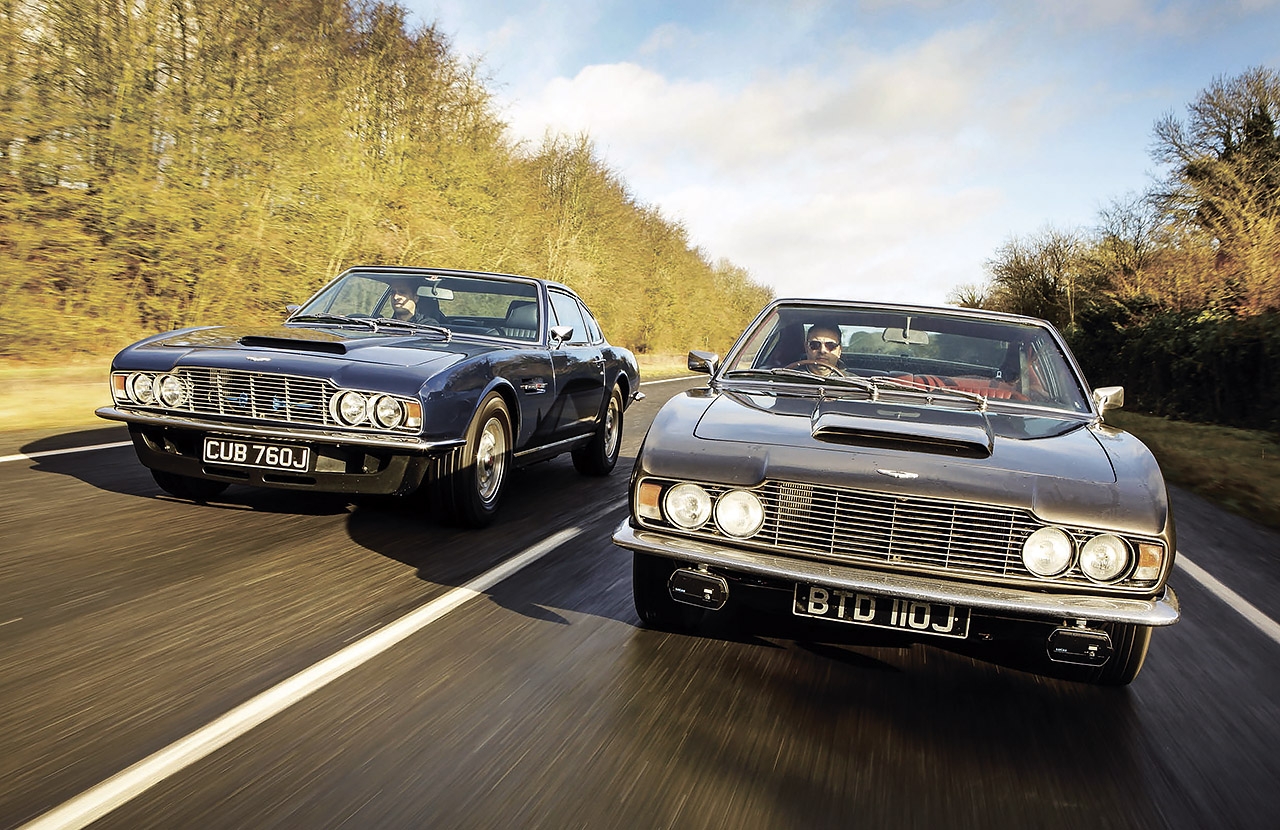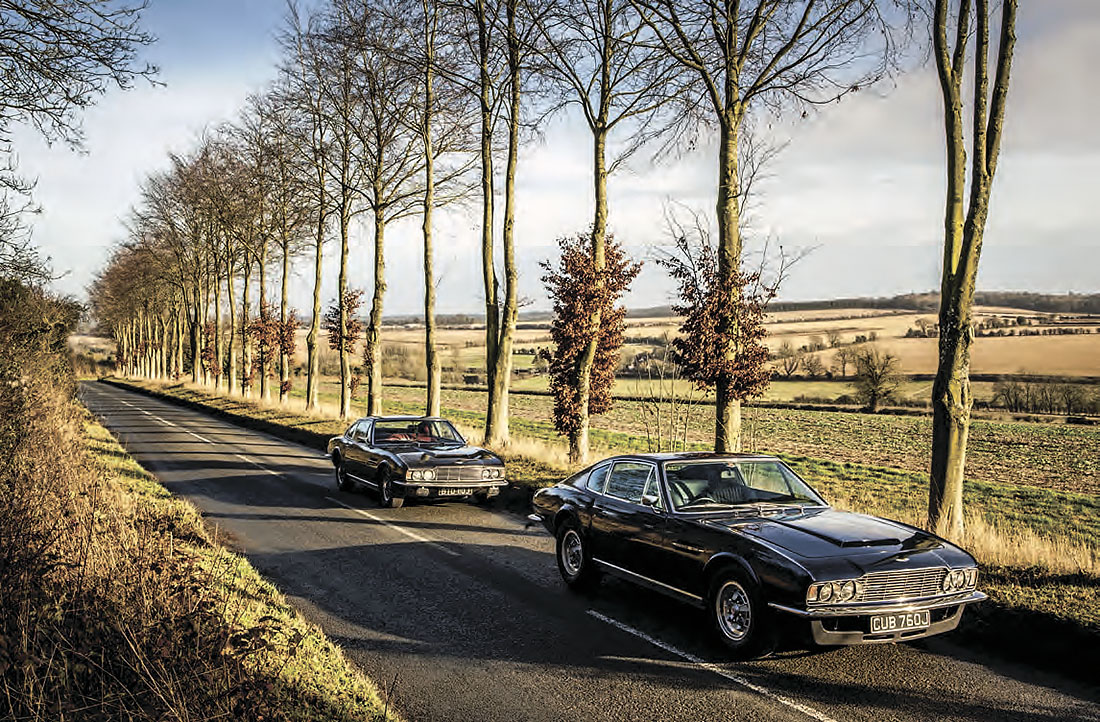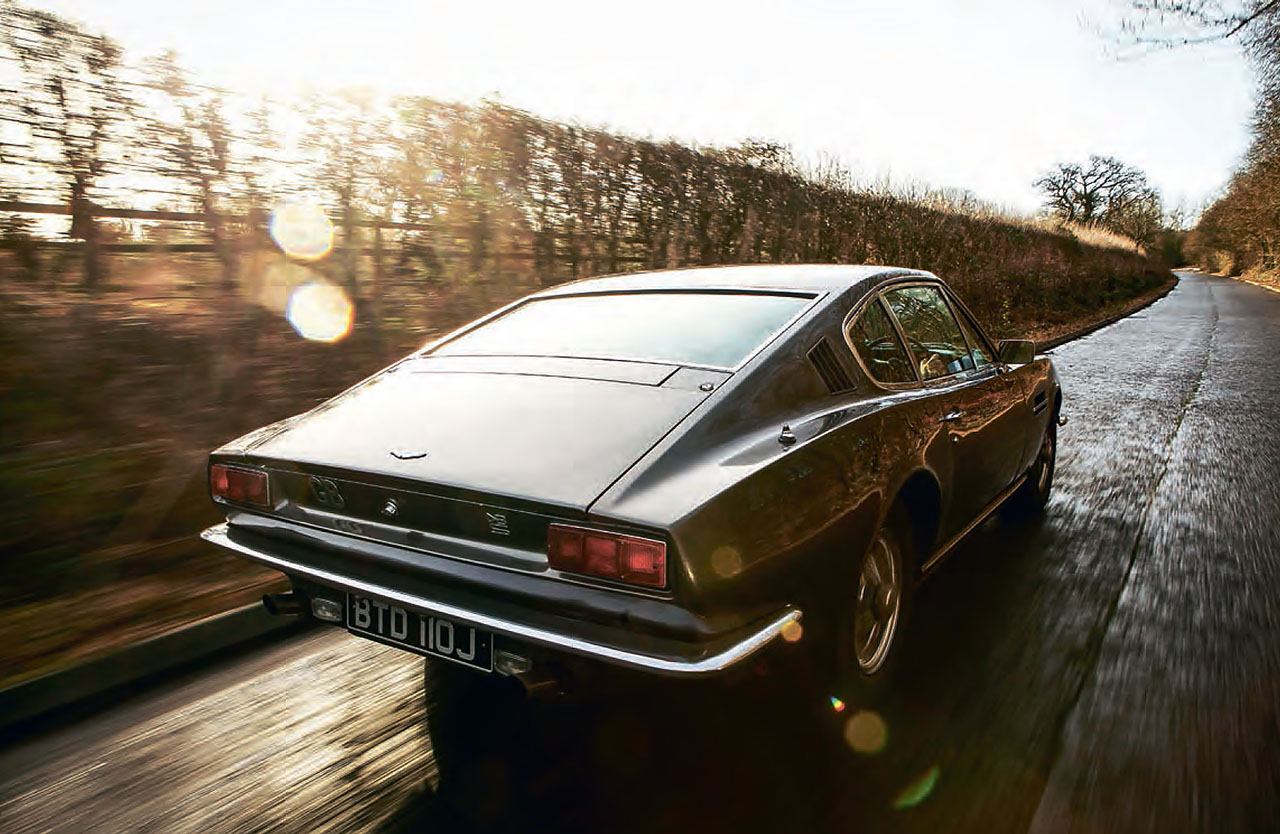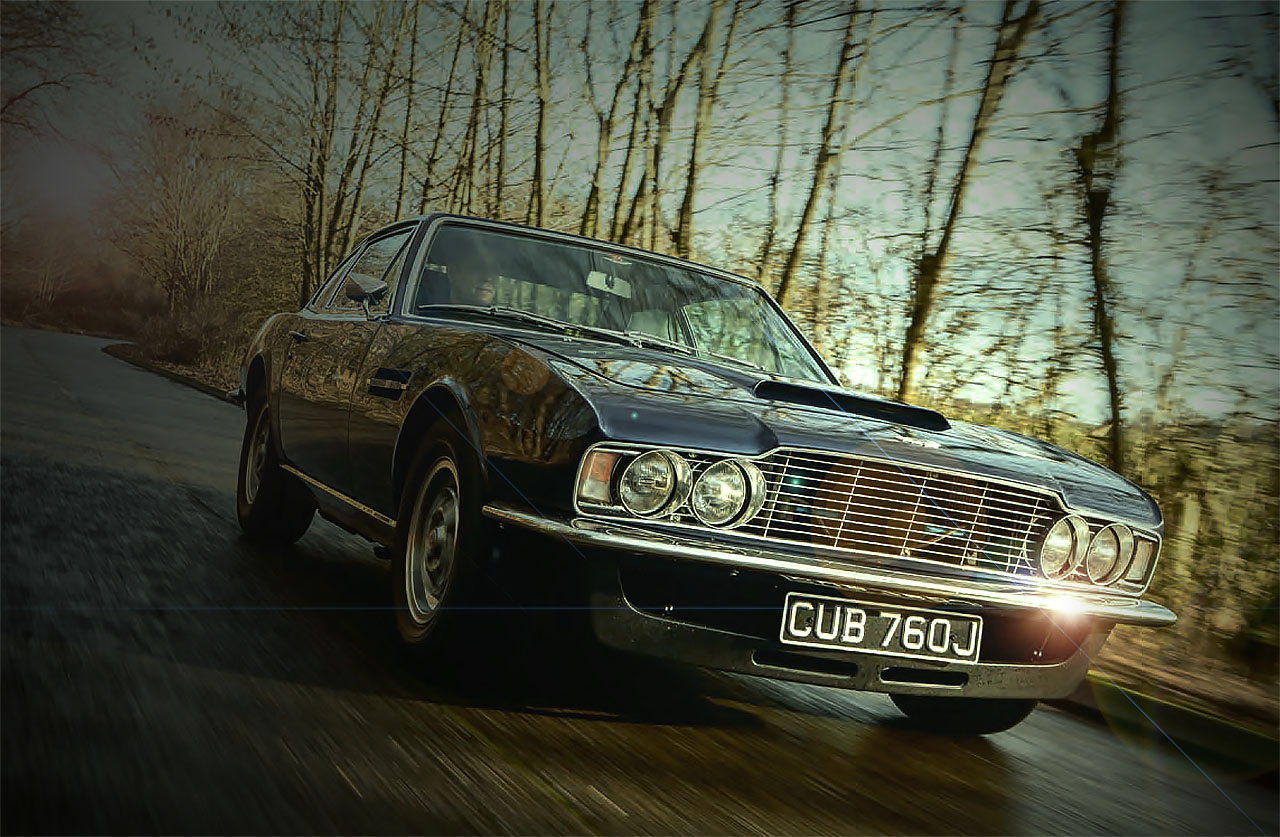
The Astons that time forgot. Aston Martin DBS. The Towns-designed stop-gap is all the rage; we pit straight six vs. V8. Unheralded for so long, the DBS is finally starting to come into its own, says Ross Alkureishi as he samples six-cylinder and V8 variants. Photography Tony Baker.
Stanley Caine, Patrick McEnroe, Aldo Andretti – none of them remembered as household names in their chosen profession, and yet each surname is more than familiar enough to register. All inhabited the same arenas as more successful siblings but each failed to scale the same heights. A similar notion could equally be applied to the DBS and DBS V8 models – the name’s familiar, as is the shape – for so long relegated to the shadow of the historical output of Aston Martin Lagonda Ltd.
Not only unlucky enough to follow the strikingly attractive DB6 – and its own DB4/DB5 forefathers – it also had a mildly restyled V8 successor that, across 18 years of production, would become ingrained in the minds of enthusiasts as the definitive ‘big’ Aston. There was an association with James Bond – usually manna from heaven for the marque – but unfortunately it was in George Lazenby’s sole outing for On Her Majesty’s Secret Service, rather than Sean Connery’s celebrated take on the super-spy.

From top: visually, the two models are all but identical – both have real presence; venerable Marek straightsix, here in standard spec; vents moved for DBSV8.
If ever a classic car had the right to figuratively sulk and bemoan its fate, then the DBS would be it. Instead, for several decades it has kept a low profile, inhabiting the ‘cheap to buy, expensive to maintain’ bracket, all the time waiting for fickle fashion to come full circle and allow it to cement its true place in the Aston hierarchy. Now, with values firmly in the ascendency, it’s time to re-evaluate this misunderstood beast.
But first a little history. Production of the DB4 started in 1958. Designed by Carrozzeria Touring of Milan, it was constructed utilising the superleggera principle of light alloy bodywork on a steel tube frame, and was powered by Tadek Marek’s all-alloy, double-overhead-camshaft sixcylinder engine. Its combination of elegant styling, bespoke construction and high performance ensured that it was a sales success. Over the next five years it morphed – via GT and GT Zagato variants – into the more powerful DB5, but by the time the DB6 arrived in 1965 it was clear that a ‘true’ successor would be required. The following year, Carrozzeria Touring was commissioned once again and completed two prototypes before abruptly going out of business.

Disaster for one party often opens the door for another, and through it stepped William Towns. He’d originally joined Aston Martin as a seat designer but this relatively fringe figure – his remit: conceiving door trim, handles and other minor items – was handed responsibility for the DBS project. The clay model he shaped went into production almost unaltered, and the design would form the company’s foundation for an incredible quarter of a century.
Unveiled at Blenheim Palace on 25 September 1967, the DBS caused a furore. Gone were the graceful lines of its predecessor, replaced instead with a massive and radical American-influenced body style that incorporated quad quartz headlights and a squared-off interpretation of that classic Aston grille. Beneath sat the familiar Harold Beach chassis from the DB6 – widened by 4½in, and with an inch-longer wheelbase – plus, for the first time on an Aston, a de Dion rear axle. If the company’s hierarchy had wished for cutting-edge styling to take its aged underpinnings into the next decade, then Towns had seemingly delivered. There was only one minor issue: the new V8 to power the car wasn’t ready.

From top: muscular rear gives an impression of the car’s width; wires for early ‘sixes’; luxurious cabin; grip is plentiful; stylish badge and controls.
The Marek-designed engine had been tested in a pair of Lola T70s at Le Mans in 1967. Both cars failed, with the block’s lack of strength quickly identified as the culprit. There was no chance of it going into production in time for the fast-approaching DBS launch, so contingency plans were quickly enacted and the DB6’s existing six-cylinder unit fitted. Customers could choose between the standard spec – 8.9:1 compression ratio, triple SU carburettors and 282bhp output – and the Vantage, with a 9.4:1 ratio, triple Webers and 325bhp. In an attempt to offset the disappointment of the delayed V8, Aston Martin offered the hotter version of the Marek ‘six’ as a no-cost option.
Today, Lee Davies’ DBS doesn’t just seem heftier than a DB6, it appears positively gargantuan. In fact, it’s 1½in shorter in the body but a whopping 6in wider. The earlier DBs look as if their light alloy bodywork has been poured over the body frame, and then lovingly sculpted. With its slab-like panels and blunt front end, the DBS offers no such illusions and instead has an inherent brutality – the only visual link to the past being its chrome wire wheels. To say that it has presence is an understatement, though – this car dominates both the space it inhabits, and that around it.
ASTON NEEDED A CUTTINGEDGE DESIGN, AND TOWNS HAD SEEMINGLY DELIVERED
The benefits of this increased heft are felt within the luxuriously appointed interior: it’s vast. There’s symmetry between looking out onto a bonnet that feels almost as wide as it is long, and sitting in a likewise cabin. Advertised in period as a true four-seater, in reality it’s still a 2+2. The driver’s seating position is well forward – you almost insert yourself into the footwell – and initially the rear-view and door mirrors feel disconcertingly close. You also sit high, reaching down to a steering wheel slightly offset to the left, but it’s comfortable and the visibility afforded in a car with thin pillars is outstanding.
Our featured example is in standard spec, and power delivery from the six-cylinder engine is instantly familiar: smooth, with a satisfying tractability throughout the rev range. With the DBS weighing in at 1589kg – 113kg heavier than the DB6 – it’s a little undercooked. Racing driver Innes Ireland had one for long-term assessment and writing in Autocar on 16 October 1969, he went further, bemoaning a distinct lack of character and stating that: ‘It must be the greatly increased width of the S over the 6 that made me feel less a part of the car.’
It does still feel outrageously wide, such that you find yourself ‘tip-toeing’ on tight country lanes. Ireland later concluded that the model did indeed have character ‘but just took a little longer to make itself felt’, and that becomes clear on wider roads. The combination of a de Dion rear axle – negating camber changes and maximising tyre/road contact – and phenomenally wide underpinnings results in confounding levels of traction. This is one big brute that really does handle. It’s clear, though, that the chassis could handle more power – and not just the extra that is on offer in Vantage spec.
THE V8 HAS THAT SAME EXCLUSIVE EXTERIOR SUIT, BUT UNDERNEATH LURKS A BIT OF A THUG
The DBSV8 finally became available in 1969. Those bottom-end issues had been consigned to history and the redesigned engine was hugely strong. The quad-cam 5340cc V8 produced c325bhp, but best of all was the thumping 400lb ft of torque. Demand was so high that the company was unable to supply one for Roger Moore’s character Lord Brett Sinclair to drive in The Persuaders!; instead, a six-cylinder DBS gained V8 alloy wheels and badges.
An Autocar road test found the power output of the V8 ‘enough to rocket this heavy car to 60mph from rest in only 6 secs and to 100mph in only 14.7 secs’ – as well as recording a ‘mean maximum speed of 161.5mph.’ The journalist also suffered a few minor issues with the Bosch mechanical fuel injection – something that would give the early cars a reputation for poor reliability – before pondering why Aston Martin Lagonda bothered to make its own V8, when there were so many cheaply available American units. He compared it to the considerably lighter, Ford-powered AC 428 – 0-60mph in 6.2 secs, top speed 142mph – and Chryslerengined Jensen Interceptor – 0-60mph in 6.4 secs, top speed 137mph. There was more to it than that, of course, because Aston Martin enthusiasts expected bespoke automobiles, and anything other than a British powerplant under the bonnet simply wouldn’t be countenanced.

The deeper front panel is one of the few giveaways on the DBSV8, which arrived two years after the six-cylinder ‘stop-gap’ had been introduced.
The featured restored Aston-Martin DBS V8 is from a private collection and it’s the closest possible thing to – and probably better than – a new car. Outside, it’s lost the Series 1 car’s louvres in the C-post – replaced by some under the rear window – plus there’s a deepening of the panels under the nose and tail, and of the stainless-steel sill covers. Due to the car’s monstrous torque, 7in-wide alloys have replaced the structurally unsuitable 6in wires, while the final difference from the DBS is the addition of new DBSV8 badges. These subtle changes aside it’s ostensibly the same car, just with a different heart.
Inside, there’s a profusion of immaculate soft hides plus expensive floor and roof coverings. It has a stronger ZF gearbox, now with a dogleg layout, but with a similarly easy to use narrow gate. The Adwest power-assisted steering isn’t too light, and the clutch is relatively easy to engage. In fact, this whole set-up isn’t at all what I expected: namely, viciously heavy controls and an automotive overdose of masculinity.
Hold that thought. Gun the throttle and, while low-speed torque appears lacking, let it build to 4000rpm and that 400lb ft rapidly lets itself be known. Two aural howitzer blasts are fired from the twin exhaust pipes and the noise continues to build to an almighty fanfare at the 6200rpm redline, as you suddenly hurtle past mere mortals in their standard motoring fare. There’s nothing gentlemanly about this car. Did someone mention a lack of manliness? Good Lord, you require only first and second gear to hit the national speed limit.

Clockwise, from left: the V8 will leave the earlier car well behind in terms of straight-line performance; later unit featured fuel injection; power-assisted steering gives a decent amount of feel in corners. From above: V8 has alloys rather than wires; roomy cabin unchanged; discreet badging for later model; modern stereo fits in well; rectangular tail-lights.
Although the engine is only 13kg heavier than the six-cylinder unit, the car itself is significantly weightier, but all of that is rendered redundant by the staggering power and the startling straight-line performance. There’s a heavy price to pay for being cheeky and indulging a heavy right foot –15mpg under normal circumstances will quickly fall to the high single digits, leaving you to play a game of fuel-gauge anxiety. The DBSV8 also gained ventilated disc brakes that are similarly effective and will bring almost two tonnes of Aston from 100mph to a standstill in just 6 secs – not that I tried to prove it. It’s one impressive piece of kit, and provides the momentous performance hike that Aston Martin always intended it to have.
Unloved for a long period of time, the DBS and DBSV8 are now enjoying a renaissance. The six-cylinder cars have sharp 1960s styling and two levels of sporting GT ‘go’ allied to a sophisticated handling package; they’re the direct link to the earlier DB models.
The DBSV8 has that same exclusive exterior suit, but underneath lurks a bit of a thug, and one that paved the way for the increasingly brutal V8s that it later morphed into.
The aesthetics have aged well over the years. If they’re to your taste then, unlike many other classic Aston Martins, you have the luxury of choice in terms of the driving experience that you desire. Both models impart a quality that, once sampled, will persuade you of its merits. There’s no real performance comparison between the standard DBS and the DBSV8 – a Vantage-spec car will close the gap but the V8 will still leave it looking like a mere cruiser. I came away from the day liking the DBS, and one day I may mature into it, but for now my choice would have to be the DBSV8 and that addictive surfeit of torque. There would be a high price to pay in terms of the absurd fuel costs, of course, but I can’t think of many better ways to spend money.
Thanks to RS Williams: 01932 868377; rswilliams.co.uk; Aston Martin Owners Club: amoc.org.
Buying and running a DBS
“Both variants are becoming more desirable,” states RS Williams’ workshop manager Neil Thompson. “Barnfind examples with the correct history and specification are now selling for £50k-plus, with some restored cars reaching more than three times that figure. Despite the extra performance from the V8 engine, the most sought-after specification is a manual DBS Vantage, followed by a standard DBS.” The exact premium you’ll pay is difficult to specify because it’s dependent on the condition of the car.
Thompson recommends that the chassis is checked, specifically the sills, which are both models’ Achilles’ heel. Another important factor is its history – how well has it been maintained? He cites getting the car inspected by a specialist as crucial: “I can’t emphasise enough how important this is. Any level of work can be carried out, but it’s essential to have a good knowledge of where to begin. If you purchase a car with the idea of respraying then enjoying, it can be an unpleasant surprise to find out that the sills need replacing. That would cost in excess of £12,000 to resolve, with a full body repaint coming in at £25,000 subject to metalwork requirements.”
In terms of running costs, if they’re well looked-after there’s no significant difference between owning a six-cylinder DBS or a V8, save for fuel: “The initial injection issues suffered by the DBSV8 are a thing of the past, and if maintained correctly it’s a pleasure.” An annual budget is tricky to nail down; it varies on a car-by-car basis: “We have restored examples that require just a yearly service and can happily cover many miles in between without any issues at all. An annual service will cost between £1800 and £2100. Of course, if a car has been less well maintained then you have to factor that in.” Engine upgrades are available for the six-cylinder unit. It can be enlarged to 4.2- or 4.7-litres; budget £25k for the former and £35k for the latter. Only standard-sized rebuilds are available on the V8 because the Bosch mechanical injection system is a limiting factor.
| Car | Aston Martin DBS | Aston Martin DBS V8 |
| Sold/number built | 1967-1973/829 | 1969-1972/402 |
| Construction | steel chassis, alloy body | |
| Engine |
all-alloy, dohc, 3995cc straight-six, three 2in SU carburettors (Vantage: three twin-choke Webers) |
qohc 5340cc V8, Bosch mechanical fuel injection |
| Max power | 282bhp @ 5500rpm (Vantage: c325bhp @ 5750cc); | 325bhp @ 5000rpm |
| Max torque | 280lb ft @ 4500rpm (Vantage 290lb ft) | 400lb ft @ 5000rpm |
| Transmission | ZF five-speed manual or Borg-Warner three-speed automatic, RWD |
Chrysler Torqueflite three-speed automatic |
| Drive | driving rear wheels | |
| Suspension: | ||
| front | wishbones, Armstrong telescopic dampers, a-r bar |
unequal wishbones |
| rear |
de Dion axle, trailing links, Selectaride dampers; coils f/r |
rear radius arms |
| Steering | rack and pinion | Adwest power assistance |
| Brakes | Girling discs all round, inboard at rear | All vented discs |
| Wheels | – | – |
| Length | 15ft 1 ¼ in (4600mm) |
|
| Width | 6ft (1830mm) |
|
| Height | 4ft 4in (1320mm) |
|
| Wheelbase | 8ft 6 ¾ in (2610mm) |
|
| Weight | 3503lb (1589kg) | 3803lb (1725kg) |
| 0-62mph | 8.6 secs (Vantage: 8.0 secs) | 6 secs |
| Top speed | 142mph | 161mph |
| Mpg | 15 | 12 |
| Price new | £5800 | £7979 |
| Value now | £50,000 | from £50,000 |
{CONTENTPOLL [“id”: 18]}





